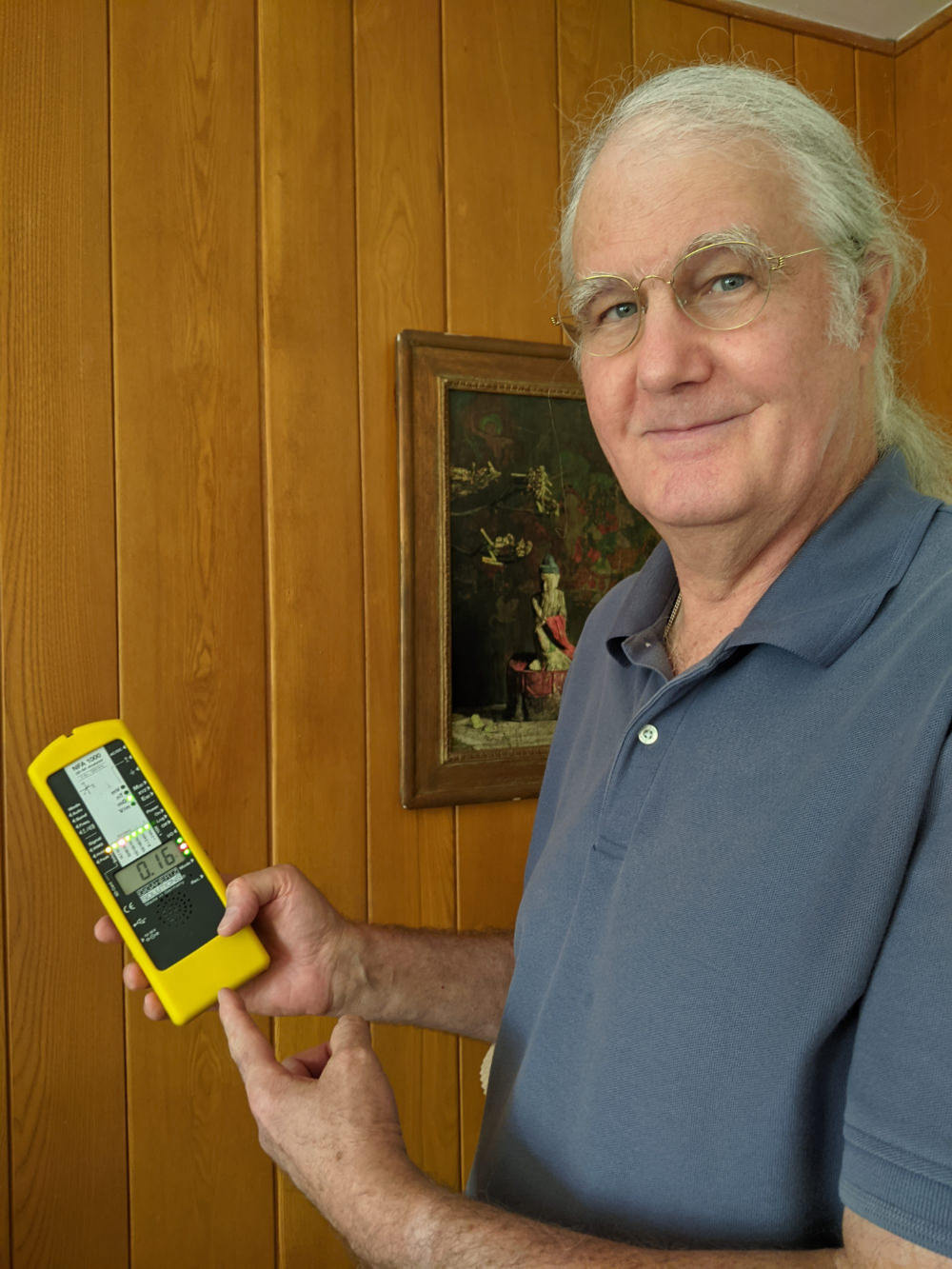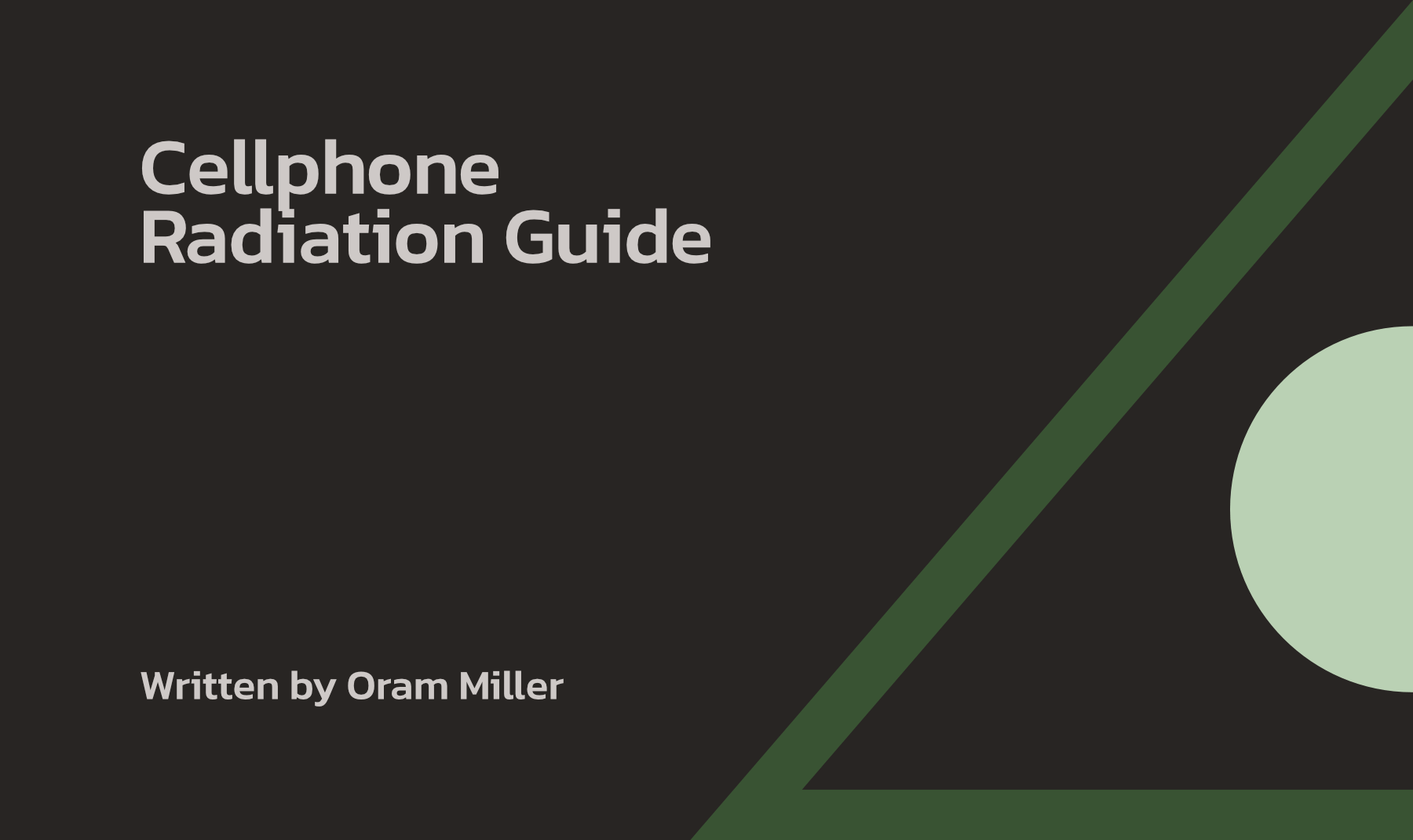To see hardwired choices for surveillance cameras, click here.
Introduction
Parents of infants and small children want to keep tabs on them while they sleep and play to be sure they are alright. Many people want surveillance cameras around their home and property, as well. Both needs are easily satisfied with a wide variety of wireless cameras and microphones available on the market today. (Click on the link above for a companion article on hardwired choices for surveillance cameras.)
The problem is, these wireless cameras emit strong radio frequency EMFs that can cause ill health for sleeping children. Even if the camera and its transmitter are several feet away, the RF level can easily exceed internationally accepted safe exposure levels for nighttime exposure as set by the EMF Safety Community and the building biology profession.
Oram was interviewed about the potential dangers of exposure to radio frequency EMFs from baby monitors by Brooke Beare, news anchor on KESQ’s CBSLocal2 News in Palm Springs, California. It aired on November 10, 2014. To read a transcript of the six minute piece, click here (the archive of the video clip is no longer available).
To provide a safe sleeping environment for everyone, we recommend using a hardwired device with a microphone and camera as your baby monitor. These would be connected to a monitor of some type (iPad, laptop, closed-circuit TV) in another room with an Ethernet, telephone or coaxial cable connection. This also helps avoid radio frequency EMFs where mom has her monitor to watch and listen to her baby, which is often by her bed and on the kitchen counter, inches away from where she sleeps and works.
One option is to use any camera and microphone that has a hardwired Ethernet connection. Here is one model that has an Ethernet port on the back:
Baby Monitors
The D-Link Indoor HD Security Camera with Day & Night Vision, Motion and Sound Detection, Model DCS-2132L-ES. The wireless transmitter shuts off when you plug in an Ethernet cable. Unfortunately, D-Link has discontinued this model, but you will be able to find it, new or used, on E-bay, by clicking here.
You would plug an Ethernet cable into the back of the camera/microphone (both D-Link models above have such an Ethernet port). You could bring that Ethernet cable from your child’s bedroom to the room where the router is located. Most people will not want to run an Ethernet cable down the hall. That Ethernet cable can, however, be run through your attic or crawl space/basement between rooms through a hole in the ceiling or floor. Or, have a professional Low Voltage Audio Video (AV) contractor run Ethernet cables through your attic, crawl space/basement and wall to a professionally installed RJ-45 Etherent data port in the bedroom.
Another option to bring hardwired Internet service into your child’s bedroom is to use a power line network adapter or Multimedia over Coaxial Alliance (MoCA) device. These use electric circuits or TV coaxial cables, respectively, in your walls to carry Internet from your camera(s) in your child’s bedroom to your router in another room in the house. This allows you to avoid Wi-Fi without having to install Ethernet cables. This is discussed on the Safer Use of Computers page in the section entitled, Network Adapters Using Electric Circuits. (Be aware that power line adapters can raise dirty electricity EMF levels, which may be able to be mitigated with plugged-in dirty electricity filters. MoCA adapters, on the other hand, do not generate any dirty electricity.)
As mentioned, the D-Link cameras and microphones that I link to above have an Ethernet jack on the back. I have verified that when you plug in an Ethernet cable that is connected to a working router, the Wi-Fi shuts off and is disabled. The camera and microphone work by sending images and sound from your child’s bedroom over the Ethernet cable. You then go online on your desktop or laptop computer to D-Link’s secure website to see and hear your sleeping baby.
You can also download an app on a mobile device (cellphone or tablet) to watch and listen that way, although that would expose mom to radio frequency EMFs from the cell phone or iPad being used as a monitor. You can, however, connect your iPhone and iPad to the web in a hardwired way while it is set to Airplane Mode. Click here for details.
If you must use a wireless baby monitor, the SmartNOVA wireless baby monitor made by Norwegian manufacturer NOVA and RadioShield Technologies is the least harmful I have found. I have measured these units and they do emit radio frequencies, but at a much lower level than other baby monitors. At six feet from the SmartNOVA, I measured radio frequency (RF) levels of only 10-20 microWatts/meter squared (µW/m2), which is at the level that we say is the beginning of the “slight anomaly” range for sleeping areas.
I would not put this unit any closer than six feet from your baby’s crib or from where mother sleeps, stands or sits in the daytime. Therefore, always put the SmartNOVA monitor across the bedroom from the crib and keep the monitor that Mom watches six feet away from her, as well. Keep in mind how far people sit or sleep on the other side of the wall from where you place the camera and monitor, because RF signals do pass through walls. Make sure people are not sleeping or sitting within six feet of the camera and monitor whether walls are present or not.
The SmartNOVA Baby Monitor sells for $149. You can order it from Bellyarmor by clicking here. It is currently back-ordered, and the manufacturer says they are working on a replacement model. You can pre-order a unit from them and find out more information about when they might have it available by going the website linked to above.
Another option may be baby monitors made by Bebcare, a company I have heard of. One model is the Bebcare Hear Audio Baby Monitor. Another is the Bebcare iQ – Smart HD Baby Monitor.
Bebcare has come up with what they call “ultra-low wireless radiation radio technology”. They say, “Lowest Radiation: Bebcare Hear baby monitor employs DSR radio technology, which reduces wireless emission by over 90% compared to other baby monitors.” I have not measured their products that I recall. I therefore cannot tell you ahead of time how low the RF level actually is where your baby would be laying in the crib when this unit is placed on the edge of the rail or on a nearby table.
If you wanted to order one of these Bebcare models, both of which apparently have this same technology, I could measure it for you if you are local, or you could measure it for yourself if you have an RF meter and we could confer by phone or video conference. The RF level will be reduced and will definitely be an improvement over what you likely have now from any regular baby monitor, which produce enormously high and, in our opinion, unhealthy RF levels for your sleeping baby. However, how low the RF level will be with a Bebcare model I cannot say without measuring it.
Secondly, Bebcare also offers what they call a “Breathing Sensor Mat”, which is apparently designed to monitor for sleep apnea. While this is laudable, I would want to know what the electric field EMF level might be for the baby sleeping on such a mat, if the power cord to the monitor is ungrounded, which it is likely to be (two-pronged) without grounding being conveyed fully to the mat. I would not advise having an infant, or anyone of any age, sleep on a mat that is not grounded. High and unhealthy AC electric field EMFs can result (even if the cord is connected by low voltage DC wiring) resulting in a highly agitating and non-restful sleep. Read my article on AC Electric Field EMFs for more information on this phenomenon.
A resource with sources of relatively low radio frequency-emitting baby monitors can be found at The Gentle Nursery, available by clicking here.
We strongly suggest, however, that you go with hardwired connections if possible because there are non-thermal, biological effects even at these low RF levels that are now being demonstrated through research. Thus, even 10-20 microWatts/meter squared is not necessarily a safe level for an infant, or for anyone else, for that matter.
Remember, in general it is always best to be safe with hardwired connections whenever you can for all your networking needs.
Finally, to see a selection of protective clothing that a pregnant woman can wear around her abdomen to protect her fetus from radio frequencies, click here or here.
Bear in mind, this does not mean we recommend that you should use a cell phone for calling, texting or web surfing if you are pregnant. Research suggests that when a fetus is exposed to wireless frequencies when the mother uses a cell phone at close range, that child has a statistically higher chance of developing behavioral, cognitive and learning impairment when they become teenagers. This is reported by obstetrician Hugh Taylor, MD at Yale University and pediatrician Martha Herbert, MD, at Harvard. Drs. Taylor and Herbert spoke at a press conference hosted by Devra Davis. This was prior to their joint presentation to pediatricians, research scientists, health care provides and policy makers at the 2016 Pediatric Societies Annual Conference in Baltimore, Maryland on May 3, 2016. To see a video of that press conference, click here.
We only make the recommendation for a pregnant woman to use belly armor clothing to protect her unborn child from radio frequencies used by those around her when she is out in public (or at home, if other members of the family still use wireless devices, which we strongly recommend against when in her presence). Belly Armor will not protect against any of the three other types of EMF.
These three other types of EMFs include the very strong magnetic fields emitted from such “point sources” as the back of a refrigerator, transformers located within digital clocks and on the front of many stoves and at the top of the lid on some dishwashers. You must measure the magnetic field exposure at these locations where you cook and prepare food. If present in your dishwasher, you can have an electrician install a shut off switch under the sink for the dishwasher and only turn it on when you use it. Flip the switch off when you don’t.
For the stove, if you have a magnetic field at the electronics at the front, find the distance where the magnetic field reading goes below 0.5-1.0 milliGauss. This is also a problem when you turn on the front burners on an electric range. Again, see what the safe distance is (below 0.5-1.0 mG) when those are turned on. You may need to stand to the side when you cook.
Closing Thoughts
See more details on this topic in my Magnetic Field EMF article, by clicking here as well as my Kitchen and Laundry Appliances and EMFs article. I have even found a transformer hidden behind the front of a gas range with no apparent evidence of electronics, just mechanical knobs to turn on gas stove-top burners. You just have to measure. To purchase a Gauss meter to measure magnetic fields, go to the page, EMF Meters and Instruments and scroll down to the section on AC Magnetic Field EMFs.
If you are pregnant, use hardwired connections exclusively for every communication need you have (phone, Internet, etc.). Use corded telephones on your land line plugged into telephone jacks throughout your house. Use your laptop or desktop computer for all your Internet needs (email, web surfing) with hardwired Ethernet connections and keep the Wi-Fi disabled on your computer. Use a corded mouse and keyboard and disable the Bluetooth on your computer.
All of these recommendations are covered in detail on my Safer Use of Computers page, accessed by clicking here

BBEC, EMRS, Certified Building Biology™ Environmental Consultant and Electromagnetic Radiation Specialist and Healthy New Building and Remodeling Consultant. Providing On-Site EMF Evaluations for Existing and New Homes and Offices in Los Angeles, Orange, Ventura, Riverside and San Diego Counties and Nationwide by Telephone and Skype. Based upon the principles of Building Biology™.






